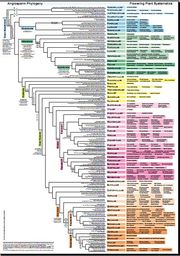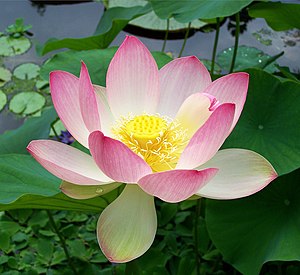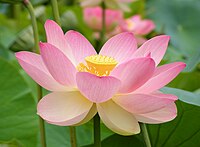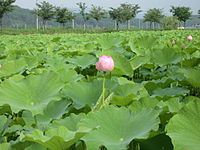Nelumbo nucifera
Read community contributed articles on biodiversity & environment || Cultural practices & mythological stories related to Indian biodiversity || Official documents related to environment || NGOs, Blogs and Websites || Environment-related video collection || Plants of India || Mammals of India || Facebook || Twitter
Share this page: Nelumbo nucifera
The Indian Lotus, also known as the Sacred Lotus, is a culturally significant plant in many Asian cultures in general and Indian culture in particular. It is a plant native to the Indian subcontinent, but now is found as an ornamental plant worldwide. The Lotus is considered a symbol of devotion and purity. It is the seat of Goddess Lakshmi, Goddess Saraswati, Lord Vishnu and Lord Brahma. The flowers of Lotus have several medicinal properties as per Ayurveda. Lotus is also the national flower of India.
Click here to see all Semantic Properties associated with this page
Please note that the above slideshow is automatically created by searching Flickr and does not contain manually curated images. Hence, it is likely that some images may not be exactly of Nelumbo nucifera.
Click on the tabs below to know more...
- Species identity and nomenclature
- Current Wikipedia entry
- Binomial Classification
- Morphological features
- Habitat and Geographical Spread
- Maps
- Medicinal Importance
- Cultural significance
- Commercial importance and cultivation
- Summary of PubMed articles
- Summary of NCBI molecular data
- External Links
- Images and Videos
| Parameter | Value(s) | References See complete references in the References section at the end |
|---|---|---|
| Names of users who have contributed to this species page | Supriyak, Gauravm | |
| Date on which this page was first created | 2010/06/13 | |
| This page was last modified on: | 1 May 2014 03:16:11 | |
| Name of the species | Nelumbo nucifera | |
| ID on Encyclopedia of Life | 596454 | |
| Synonyms | Please check Binomial Classification section for synonyms. | |
| Common English Names | Water Lily, Lotus, Sacred Lotus, East Indian Lotus | |
| Common Hindi Names | कमल Kamal | |
| Common Indian names | कमल, Kamal, Pundarika, पद्म, Padma (Hindi); থম্বাল, Thambal(Manipuri); Pandkanda, कमल Kamal(Marathi); செந்தாமரை, chenthaamarai, Tamarai, அம்பல், Ambal(Tamil); Tamara(Malayalam); Tamara, Erra-tamara(Telugu); Tavare-gadde(Kannada); কমল, Komol, পদ্মা Padma(Bengali); Padam(Oriya); نیلوفر, Nilufer(Urdu); Padam(Assamese); Motunkamal(Gujarati); सरसिज, Sarsija, Pankeruha , शारदा, Sharada, अम्बुज, Ambuj (Sanskrit) | FoI |
| Origins/Meanings of the common names |
Taxonomy from Encyclopedia of Life
If nothing is displayed in this section, it means the EoL ID has not been defined. Please click on Edit with form button on top and follow the instructions for filling in the EoL ID
{{#EoLOnlyHierarchy:596454}}
Taxonomy filled in form

Click here for the PDF of the phylogeny
| Taxon | Value |
|---|---|
| Regnum (Kingdom) | Plantae |
| Division | Magnoliophyta |
| Class | Magnoliopsida |
| Order | Nymphaeales |
| Family | Nelumbonaceae |
| Genus | Nelumbo |
| Source of data | Encyclopedia of Life |
| ||||||||||||||||||||
| Division | Taxon details | Taxon morphology details |
|---|---|---|
| Magnoliophyta | Also called Angiospermae. The ancestors of flowering plants diverged from gymnosperms around 245–202 million years ago, and the first flowering plants known to exist are from 140 million years ago. They diversified enormously during the Lower Cretaceous and became widespread around 100 million years ago, but replaced conifers as the dominant trees only around 60-100 million years ago. | These are seed plants like Gymnosperms, but can be differentiated by the presence of flowers, seeds containing endosperm and seeds that produce a fruit. Angiosperms are the most diverse and highly evolutionarily successful group of land plants. |
| ||||||||||||||||||||
| Class | Taxon details | Taxon morphology details |
|---|---|---|
| Magnoliopsida | Magnoliopsida is the scientific name for dicots. This class contains about ~1,99,350 species of Angiosperms. Eudicots are a subset of Dicots. Based on chloroplast DNA sequences, the divergence date between monocots and dicots is estimated to be ~200 million years, with a 40 million years uncertainty. | Dicots are diverse in habit, with half of all the species being more or less woody-stemmed - a reflection of the usual presence of a vascular cambium in the class. Annuals, biennials, vines, epiphytes, aquatics, parasites, and saprotrophs are also well represented in dicots. Vascular bundles of the stem are usually borne in a ring that encloses the pith. Vessel elements present except in some putatively primitive woody or aquatic families. Most dicots have a primary root system derived from the radicle, although some have an adventitious root system commonly seen in the class of monocots. Cotyledons are usually 2, seldom 1, 3, or 4. Leaves are mostly net-veined. |
|
|
|
Based on classification
More details can be found in the Binomial Classification section.
Morphology from Encyclopedia of Life
If nothing is displayed in this section, it means the EoL ID has not been defined. Please click on Edit with form button on top and follow the instructions for filling in the EoL ID
{{#EoLOnlyDescription:596454}}
General morphology
| Parameter | Value(s) | References See complete references in the References section at the end |
|---|---|---|
| General morphological features of the plant | Petiole 1-2 m long, terete, fistulous, glabrous or papillae hard and scattered; leaf blade abaxially blue-green, orbicular, 25-90 cm in diameter, papery, glabrous, glaucous, water-repellent, margin entire. Flowers 10-23 cm in diameter; peduncles longer than petioles, glabrous or sparsely spinulate. Tepals caducous, pink or white, oblong-elliptic to obovate, 5-10 cm long, 3--5 cm wide. Stamens slightly longer than receptacle; filament slender; anther linear, 1-2 mm long; connective appendage clavate, to 7 mm, incurved. Receptacle accrescent, turbinate, 5-10 cm in diameter. Fruit oblong to ovoid, 1.0-2.0 cm long, 7-15 cm wide, glabrous; pericarp thick, hardened."Petiole 1-2 m long, terete, fistulous, glabrous or papillae hard and scattered; leaf blade abaxially blue-green, orbicular, 25-90 cm in diameter, papery, glabrous, glaucous, water-repellent, margin entire. Flowers 10-23 cm in diameter; peduncles longer than petioles, glabrous or sparsely spinulate. Tepals caducous, pink or white, oblong-elliptic to obovate, 5-10 cm long, 3--5 cm wide. Stamens slightly longer than receptacle; filament slender; anther linear, 1-2 mm long; connective appendage clavate, to 7 mm, incurved. Receptacle accrescent, turbinate, 5-10 cm in diameter. Fruit oblong to ovoid, 1.0-2.0 cm long, 7-15 cm wide, glabrous; pericarp thick, hardened." cannot be used as a page name in this wiki. | EoL from Plants of Tibet |
| Seed dispersal mechanism | Anemophily (By wind), Hydrophily (By water) | |
|---|---|---|
| Bloom type | Perennial | EoL, AHSEncyclo |
| Life cycle of the plant | The plants also attract insects and are also anemophilous in their pollen/seed dispersal. The flowers bloom in the morning and wither away later in the day. | Gauravm |
How to identify this species
For a detailed description, refer to the General Morphology details above
| Parameter | Value(s) | References See complete references in the References section at the end |
|---|---|---|
| Type of plant | Herb | |
| Plant height | Up to 3 feet | Based on images |
| Flower color | Pink | EoL |
| Flower shape | ||
| Floral symmetry | ||
| Phyllotaxy of leaves | ||
| Leaf shape | ||
| Is the leaf petiolated or sessile? | Petiolated | EoL |
| Is the leaf simple or compound? | Simple | EoL |
| Parameter | Value(s) | References See complete references in the References section at the end |
|---|---|---|
| IUCN Conservation Status | Not Evaluated | EoL |
| Indian States in which the species has been documented | Assam,Andhra Pradesh,Bihar,Delhi,Goa,Jammu and Kashmir,Karnataka,Kerala,Madhya Pradesh,Maharashtra,Manipur,Rajasthan,Tamil Nadu,Tripura,Uttar Pradesh,West Bengal | FoI, Plants Database |
| Locations at which the species has been documented | Akola;Alwar;Bangalore;Bastar;Bhagalpur;Bhilwara;Bhopal;Bilaspur;Bundi;Champaran;Chandrapur;Chikmaglore;Coimbatore;Damoh;Dehradun;Gorakhpur;Hassan;Indore;Jhalawar;Jodhpur;Kodagu;Kolhapur;Kurnool;Madurai;Majuli;Maldah;Mandla;Manipur;Central;Mirzapur;Mysore;Mysore;Pune;Raigad;Raipur;Ramnathapuram;Sagar;Shimla;Shimoga;South Arcot;Srinagar;Tiruchchirappalli;Tirunelveli;Tonk;Trichurapalli;Udaipur;West Godavari | Plants Database |
| Biotic zones inhabited | Northeastern Himalayas, Northwestern Himalayas, Eastern Ghats, Western Ghats, Central Deccan Plateau, East Coast, Indo-Gangetic Plain | Based on Plants of India |
| Details about the habitat | Rooted hydrophyte. The plant has firm roots in the mud and flowers out of the water surface. Hence it needs shallow water bodies to grow. It grows in permanent water bodies,small ponds and shallow areas of lakes and rivers, upto altitudes of 400m. The plant adds to the dissolved oxygen in water and thus is important for the health of the flora and fauna in the water bodies. It also provides solid substrate and shade for its cohabitants.
The plant is also found abundantly in China and other East Asian countries, where also it is highly culturally integrated. It is possible that the locus of origin of Nelumbo nucifera is the sub-Himalayan region. |
EoL, Naturia |
| Is this species native to India? | Yes | Wikipedia |
| Is the species indigenous/endemic to Sub-Himalayan regions? | Yes | |
| Is the species indigenous/endemic to Western Ghats? | ||
| Is the species indigenous/endemic to Eastern Ghats? |
More plants native to India
| ||||||||||||||||||||||||||||||||||||||||||
If no maps are displayed below, it means the required data is absent. Click on "Edit with form" button on top of the page to add this information.
{{#generateMap:Assam,Andhra Pradesh,Bihar,Delhi,Goa,Jammu and Kashmir,Karnataka,Kerala,Madhya Pradesh,Maharashtra,Manipur,Rajasthan,Tamil Nadu,Tripura,Uttar Pradesh,West Bengal|Nelumbo_nucifera_brahma.svg|align=center}}
| Parameter | Value(s) | References See complete references in the References section at the end |
|---|---|---|
| Does this species have any medicinal use? | Yes |
|
Other plants of the same family having medicinal use:
|
| Parameter | Value(s) | References See complete references in the References section at the end |
|---|---|---|
| General types of ailments this species is used for treating | Infectious diseases, Common ailments, Systemic disorders, Organ-specific disorders | |
| Specific ailments for which the species is used | Diarrhea, Dysentry, Cholera, Piles, Ring worm, Fever, Leprosy, Snake Bite, Dyspepsia | Sasya |
| Medicinal systems which use this plant | Ayurveda, Modern Medicine | Sasya |
| Details of Medicinal use | Flower- astringent, in diarrhoea, cholera, diseases of liver and heart; filament – in bleeding piles and menorrhagia; rhizome in piles, dysentery, dyspepsia, and skin diseases including ring worm; young leaf in fever; seed used for local application in leprosy and other skin affections; pistil-antidote in snake poisoning, demulcent, antiemetic.Rhizomes are given to Children in diarrhoea and dysentry. | Sasya Sampada |
| Parts of the plant used for treatment | Root, Rhizome, Leaves, Flower, Fruit, Seeds, Other | Sasya |
| Names of some medicinal active compounds in this plant, if known. | ||
| Details of the active chemical compounds found in this plant | Quercetin, Luteolin, their glycoside derivatives and kaempferol glycoside are obtained from flowers and leaves. Leaves also contain benzyl tetrahydroisoquinoline, aporphine and 6a, 7-dehydroaporphine type of alkaloids. Thus basesroemerine, nuciferine, anonaine, pronuciferine, N-nor-nuciferine, liriodenine, nor-nuciferine, armepavine, N-methylcoclaurine, dehydronuciferine, dehydroroemerine, dehydroanomaine and N-methylisococlaurine have been obtained from the leaves, seed oil consisted mainly of linoleic, linolenic, palmitic acid oleic acid, with a small quantity of myristic acid. | Sasya Sampada |
| Is the molecular basis of the medicinal action known? | ||
| Details of molecular basis of action | Several studies performed using flower, leaf and seed extracts on mice have indicated that the extracts have antioxidant properties and are hepatoprotective. However, the molecular basis of the medicinal properties are yet not known. | Google Scholar search |
| Are the toxic effects of consumption of this plant known? | ||
| Details of the toxic effects of the plant species | ||
| Have there been validation/clinical studies related to this plant? | ||
| Details of the clinical studies related to the plant species |
| Parameter | Value(s) | References See complete references in the References section at the end |
|---|---|---|
| Is this plant/plant-derived product used in food preparations? | Yes | User-reported |
| Part(s) of the plant used in the food preparations | Rhizomes, Leaves | |
| Details of use in food preparations | Edible rhizomes,stem and seeds,leaves are used to serve as food plates. Lotus is highly used in cuisines in many East Asian cultures such as Vietnamese, Chinese and Korean food. (Wikipedia) | |
| Does this species have any religious significance? | Yes | User-reported |
| Religions which mention/give significance to this species | Hinduism, Buddhism | Based on images |
| Religious occasions | ||
| Details of religious use | Lotus is a symbol of purity and innocence. It is the seat of Goddess Saraswati, Goddess Lakshmi, Lord Vishnu and Lord Brahma. It is most significantly associated with Lord Brahma. Lotus flowers are used as offerings in Indian temples. | Sasya Sampada |
| Parameter | Value(s) | References See complete references in the References section at the end |
|---|---|---|
| Is this plant cultivated commercially in India? | Yes | Gauravm |
| Uses for which the plant is commercially cultivated | Human consumption, Ornamental use, Religious use | gauravm |
| Plant parts of commercial value | Entire plant, Root, Rhizomes, Stem, Leaves, Flower, Fruit, Seeds | |
| Products where this plant is used | User-reported | |
| Description of use | Almost all parts of the plant have medicinal and culinary uses as previously described. The plant is also a prized ornamental plant, especially in artificial ponds. | Gauravm |
| States where this plant is cultivated commercially | ||
| Best period for planting this plant | Summer, Monsoon | AHS Encyclo |
| Best period for harvesting this plant | Post-monsoon | |
| Method of propagation | Seeds | |
| Water requirement of this plant | High | |
| Pests and Diseases affecting this plant during cultivation | Leaf spots, Caterpillars, Spider mites, Whiteflies | AHS Encyclo |
| Other considerations while cultivating this plant | Plant needs several weeks of full sunlight and temperatures above 25C. Needs good amount of fertilizer during peak growth. Start growing in a shallow container and gradually lower depth as plant grows. If several seeds are planted together, the rhizomes of the grown plants get entangled with each other. The rhizomes are very fragile and need to be separated carefully before transferring to another location. | AHS Encyclopedia |
Pubmed Word cloud
This word cloud is obtained using the tool LigerCat by searching the Pubmed database. LigerCat builds the cloud from the most relevant Medical Subject Headings (MeSH) terms. Each term's relative size indicates how many times it appears in the PubMed search results. Click on a term to access the full LigerCat cloud, with live PubMed search capabilities. LigerCat has been developed for the Biology of Aging Project.
The page may take some time to load since LigerCat is searching the entire PubMed database and sending us the results in real time.
- If there is an error message below, it means that there is no retrievable information available on NCBI
- If the number of nucleotide sequences is less than 100, very little genomic work has been done on this species. A respectable number of nucleotide sequences is above 10000.
- Most of the nucleotide sequences may come from three sources:
- Studies on single genes, where people try to sequence genes such as some specific dehydrogenases important,say, for tannin production
- Sequences of Ribosomal Internal Transcribed Spacer, whose sequence is used for generating molecular phylogenetic trees to establish species relationships
- Expressed Sequence Tags (ESTs) which can tell about which genes are present and expressed in the species at a particular time in the given tissue
{{#queryDB:taxonomy |Nelumbo nucifera }}
| Parameter | Value(s) | References See complete references in the References section at the end |
|---|---|---|
| Details of modern scientific knowledge available for this species | The sacred lotus attracts pollinators by producing heat through a nonphosphorylating electron transport pathway that releases energy by electron flow through an alternative respiratory pathway.The alternative pathway of respiration, catalysed by the Alternative Oxidase (AOX), is responsible for heat production in the sacred lotus.(EoL through Biomimicry Institute)
Some EST sequences from this plant are available (Sep 2010). There is very little known about the molecular basis of the medicinal properties of the plant. The molecular basis of development of lotus flowers is also not clearly known. |
EoL through Biomimicry Institute, NCBI Taxonomy, Google Scholar search |
| Are herbarium specimen available for this species? | ||
| Institutes having herbarium samples |
If nothing is displayed in this section, it means the EoL ID has not been defined. Please click on Edit with form button on top and follow the instructions for filling in the EoL ID
{{#EoLOnlyAdditionalInfo:596454}}
References
AHS Encyclo (Book) : American Horticulture Society (2008),', ISBN: 9780756649159
EoL (Web): EoL entry on Nelumbo nucifera, Accessdate=2010-07-01
PDI (Web): Plant Database of Indiahttp://221.135.191.194/sasya/showhtml.php?d=html_files/Nelumbo%20nucifera2/Nelumbo%20nucifera.htm#Habit and Habitat entry on Lotus, Accessdate=2010-07-01
Sasya (Web): Sasya Sampada entry on Lotus, Accessdate=2010-07-30
FoI (Web): Flowers of India entry on Lotus, Accessdate=2010-07-30
Naturia (Web): Naturia, Accessdate=2010-09-29
| This article is a stub. You can help Project Brahma by expanding it. |


